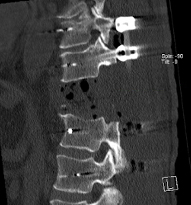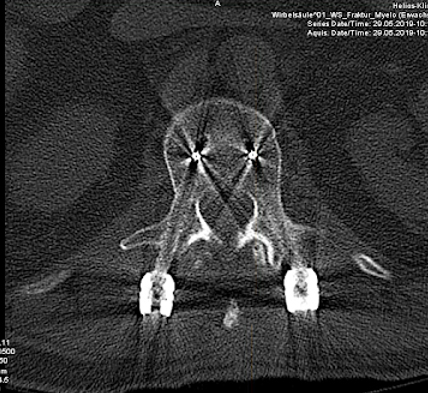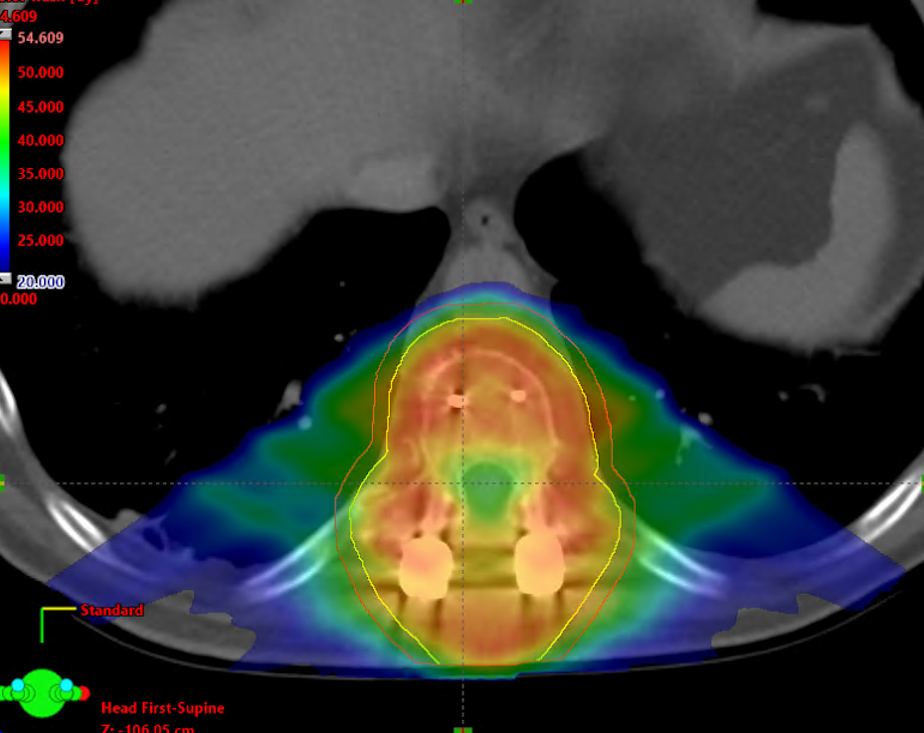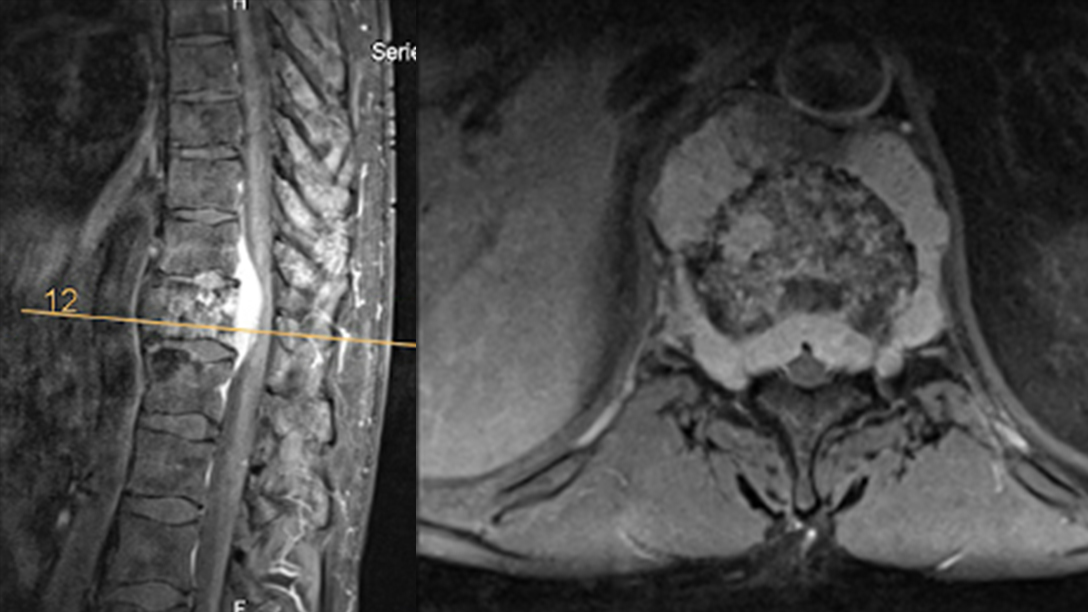Fall 2
BlackArmor® Carbon/PEEK Implantate ermöglichen den Einsatz hochpräziser Protonentherapie
Verdacht auf Spinalmetastasen in Th11 bei einer 60-jährigen Patientin. Das MRT zeigt eine Läsion, die das Rückenmark komprimiert.
Therapieweg
Chirurgische Versorgung mittels Laminektomie, Debulking, Biopsie und dorsaler Stabilisierung mit Titanimplantaten.
Histologischer Befund: Chordom. Die hieraus resultierende Entscheidung für eine adjuvante Protonentherapie forderte die Revision der dafür kontraindizierten Titanimplantate und den Einsatz von BlackArmor® Carbon/PEEK Implantaten.
Ersatz der Titanimplantate durch BlackArmor® Carbon/PEEK Implantate, dorsale perkutane Stabilisierung mit dem VADER® Pedicle System und Wirbelkörperersatz mit dem KONG®-TL VBR System


Eine exakte Planung und sichere Durchführung der indizierten Protonentherapie konnten vorgenommen werden.

17 Monate postoperativ kein radiologischer Nachweis eines Tumors
BlackArmor® Carbon/PEEK erweitert die strahlentherapeutischen Optionen.1Shi C. et al. (2022): Comprehensive Evaluation of Carbon-Fiber-Reinforced Polyetheretherketone (CFR-PEEK) Spinal Hardware for Proton and Photon Planning. Technology in Cancer Research & Treatment. (PubMed, PMID: 35410544)5Schmidhalter D. et al. (2020): Dosimetric Analysis of Spine SBRT in Case of CFR-PEEK Implants. Annual SASRO Meeting.7Poel R. et al. (2020): Assessing the Advantages of CFR-PEEK over Titanium Spinal Stabilization Implants in Proton Therapy – A Phantom Study. Physics in Medicine and Biology. (PubMed, PMID: 32315991)8Henzen D. et al. (2022): Feasibility of Postoperative Spine Stereotactic Body Radiation Therapy in Proximity of Carbon and Titanium Hybrid Implants Using a Robotic Radiotherapy Device. Radiation Oncology. (PubMed, PMID: 35549961)Da die Tumorentität präoperativ nicht immer feststeht, ist die primäre Wahl der Implantate essenziell. Spitzentechnologien wie stereotaktische Strahlentherapie (stereotactic body radiotherapy, SBRT) und Protonentherapie sind hochwirksam und oftmals indiziert, wenn die konventionelle Strahlentherapie an ihre Grenzen kommt. Eine artefaktfreie Bildgebung ist umso wichtiger, da die Risikoorgane bei der Planung sehr genau abgegrenzt werden müssen. Durch BlackArmor® Carbon/PEEK kann dieser Prozess, ebenso wie die Bestrahlungsapplikation selbst, optimiert werden.1Shi C. et al. (2022): Comprehensive Evaluation of Carbon-Fiber-Reinforced Polyetheretherketone (CFR-PEEK) Spinal Hardware for Proton and Photon Planning. Technology in Cancer Research & Treatment. (PubMed, PMID: 35410544)2Krätzig T. et al. (2021): Carbon-Fiber-Reinforced PEEK versus Titanium Implants: An In Vitro Comparison of Susceptibility Artifacts in CT and MR Imaging. Neurosurgical Review. (PubMed, PMID: 32930911)3Müller BS. et al. (2020): The Dosimetric Impact of Stabilizing Spinal Implants in Radiotherapy Treatment Planning with Protons and Photons: Standard Titanium Alloy vs. Radiolucent Carbon-Riber-Reinforced PEEK Systems. Journal of Applied Clinical Medical Physics. (PubMed, PMID: 32476247)4Klippel N. (2018): Dosimetric Impact of Titanium and Carbon Implants in Photon Therapy. Annual SSRMP Meeting.5Schmidhalter D. et al. (2020): Dosimetric Analysis of Spine SBRT in Case of CFR-PEEK Implants. Annual SASRO Meeting.6Ringel F. et al. (2017): Radiolucent Carbon Fiber-Reinforced Pedicle Screws for Treatment of Spinal Tumors: Advantages for Radiation Planning and Follow-Up Imaging. World Neurosurgery. (PubMed, PMID: 28478252)7Poel R. et al. (2020): Assessing the Advantages of CFR-PEEK over Titanium Spinal Stabilization Implants in Proton Therapy – A Phantom Study. Physics in Medicine and Biology. (PubMed, PMID: 32315991)
